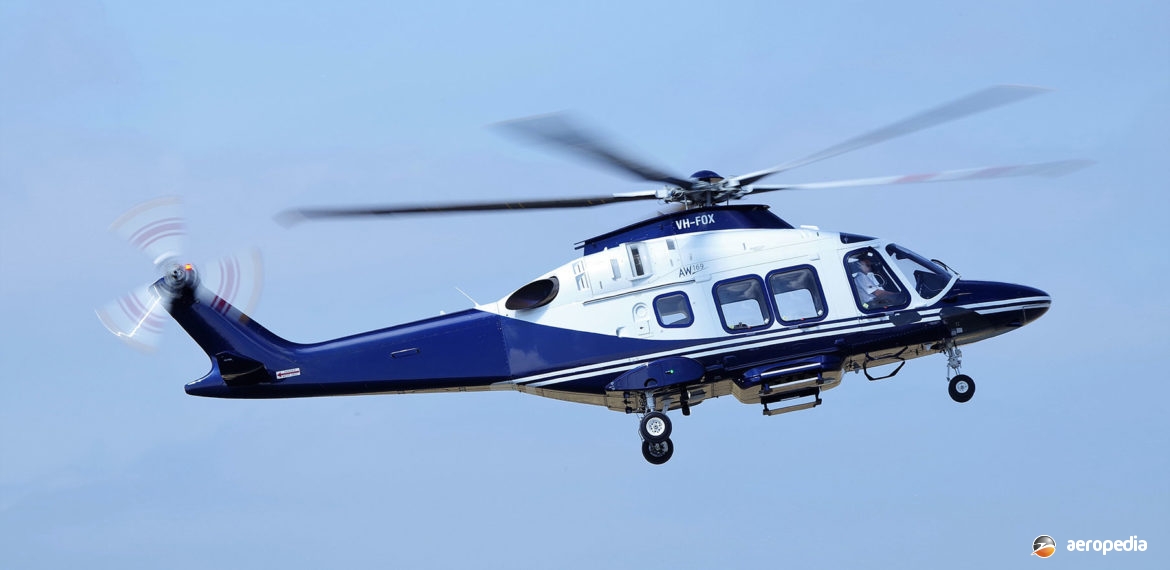Photograph:
Agusta Westland AW-169 VH-FOX (c/n 169009) at the Australian International Air Show at Avalon, VIC in March 2017 (David C Eyre)
Country of origin:
Italy / Great Britain
Description:
Multi-purpose utility helicopter
Power Plant:
Two 750 kw (1,100 shp) Pratt & Whitney Canada PW210A turboshafts
Specifications:
- Length: 13 m (42 ft 8 in)
- Rotor diameter: 12.2 m (40 ft)
- Max speed: 313 km/h (194 mph)
- Cruising speed with fixed undercarriage: 259 km/h (161 mph)
- Cruising speed with retractable undercarriage: 277 (172 mph)
- Range with fixed undercarriage: 852 km (529 miles)
- Range with retractable undercarriage: 926 km (575 miles)
- Max endurance: 3.17 hrs.
- Cabin volume: 6.28 m³ (222 cub ft)
- Baggage volume: 1.29 m³ (45.9 cub ft)
- Empty weight: 2,700 kg (5,952 lb)
- Loaded weight: 4,500 kg (9,921 lb)
History:
The AW-169 was a development of the AW-139 and shares a common cockpit with the Company’s AW-139 and AW-189. It was designed for medical and search-and-rescue duties, law enforcement and passenger transport, and offshore and utility services. On the market it competes with the EC-145, Bell 429 and AS-365 Dauphin in the light utility helicopter role. Agusta Westland, a Finmeccanica company, announced the launch of the type at the Farnborough Air Show in July 2010.
The first prototype (I-EASF) made its first flight on 13 May 2012 at the Company’s factory at Cascina Costa in Italy. At that time the Company had received orders for 50 aircraft and had an expectation of selling 1,000 examples over a period of 20 years. Seating a maximum of 10, the design made extensive use of composites in its construction. Three more prototypes entered the certification program, one in 2012, another in 2013, with certification being obtained in 2014.
The aircraft had the latest technology for maximum situational awareness and all-weather operations, including a full digital NVG compatible cockpit with three large area displays with enhanced graphics capability. It hads a four-axis digital automatic flight control system (DAFCS) with dual Flight Management System (FMS) to minimise crew workload allowing single / dual pilot VFR / IFR operations. Power is provided by two FADEC-controlled Pratt & Whitney Canada PW210 turboshafts. Capacity is a crew of two pilots and up to eight or ten passengers, or two stretcher patients.
An announcement was made in 2013 that two examples had been ordered by a New Zealand company; and Linfox Australia became the first Australian customer, announcing in July 2012 at the Farnborough Air Show that it had ordered three examples in full VIP configuration. At the Australian International Air Show at Avalon in February 2015 a mockup of the new helicopter was placed on display.
First example of the type registered in this part of the world became VH-FOX12 (c/n 169009) on 18 December 2015, registered to Fox Helicopters Pty Ltd of Melbourne, VIC, being followed by VH-LSN4 (c/n 69017 – ex I-EASL) registered on 8 February 2016 to Hudcon Properties Pty Ltd of South Melbourne. However, this latter machine was cancelled from the register on 12 October 2016, being exported to the United Kingdom where it became G-CMCL.
In May 2017 VH-FOX12 (c/n 69009 – ex I-RAIS) became VH-LHH4; and a new example became VH-FOX13 (c/n 69034 – ex I-EASL) also registered to Fox Helicopters of Melbourne on 26 May 2017.
First example in New Zealand was imported and put into service by the Auckland Helicopter Rescue Trust , being registered as ZK-HLH (c/n 69082) on 2 August 2018.

